Nan Goldin interviewed by Adam Mazur and Paulina Skirgajllo-Krajewska
If I want to take a picture, I take it no matter what
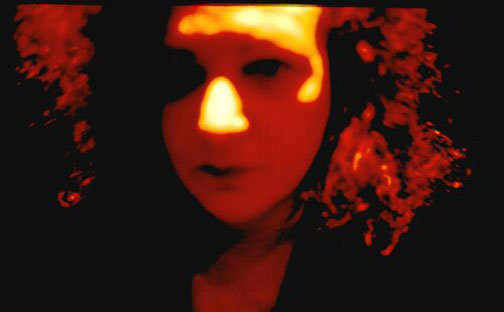
Nan Goldin - Self-portrait red. Zurich. 2000
72.00 xI 04.00 x 4.50 cm Matthew Marks Gallery
|
See also: |
Your approach towards photography is very personal. Is not it a kind of therapy?
Yes, photography saved my life. Every time I go through something scary, traumatic, I survive by taking pictures.
You also help other people to survive. Memory about them does not disappear, because they are on your pictures.
Yes. It is about keeping a record of the lives I lost, so they cannot be completely obliterated from memory. My work is mostly about memory. It is very important to me that everybody that I have been close to in my life I make photographs of them. The people are gone, like Cookie, who is very important to me, but there is still a series of pictures showing how complex she was. Because these pictures are not about statistics, about showing people die, but it is all about individual lives. In the case of New York, most creative and freest souls in the city died. New York is not New York anymore. I've lost it and I miss it. They were dying because of AIDS.
You decided to leave the United States because of the effect the AIDS epidemic had on the community of New York gay artists and writers?
I left America in 1991 to Europe. I went to Berlin partially because of that, and partially because one of my best friends, Alf Bold, was dying and I stayed with him and took care of him. He had nobody to take care of him. I mean, he had lots of famous friends, but he had nobody to take care of him on a daily basis. He was one of people who invented the Berlin film festival. This was also the time when my Paris photo dealer Gilles died of AIDS. He had the most radical gallery in the city. He did not tell anybody in Europe that he has AIDS, because the attitude here was so different than in the United States. There was no ACT UP in Paris, and in 1993 it looked very much like in the US in the 1950s. Now it has changed, but at that time people in Europe told me: 'Oh, we do not need ACT UP. We have very good hospitals'.
Your art is basically socially engaged...
It is very political. First, it is about gender politics. It is about what it is to be male, what it is to be female, what are gender roles... Especially The Ballad of Sexual Dependency is very much about gender politics, before there was such a word, before they taught it at the university. A friend of mine said I was born with a feminist heart. I decided at the age of five that there was nothing my brothers can do and I cannot do. I grew up that way. It was not like an act of decision that I was going to make a piece about gender politics. I made this slideshow about my life, about my past life. Later, I realized how political it was. It is structured this way so it talks about different couples, happy couples. For me, the major meaning of the slideshow is how you can become sexually addicted to somebody and that has absolutely nothing in common with love. It is about violence, about being in a category of men and women. It is constructed so that you see all different roles of women, then of children, the way children are brought up, and these roles, and then men, then it shows a lot of violence. That kind of violence the men play with. It goes to clubs, bars, it goes to prostitution as one of the options for women - prostitution or marriage. Then it goes back to the social scene, to married and re-married couples, couples having sex, it ends with twin graves.
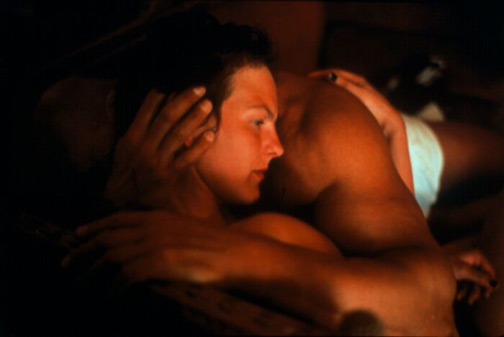
Nan Goldin - Valerie and Gotscho embraced, Paris, 1999, Galerie Yvon Lambert
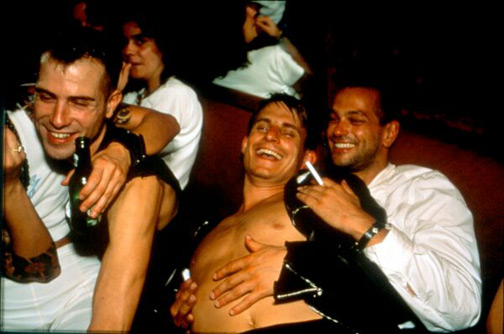
Nan Goldin - Clemens, Jens and Nicolas laughing at Le Pulp. Paris. 1999
72.00 xI 04.00 x 4.50 cm Matthew Marks Gallery
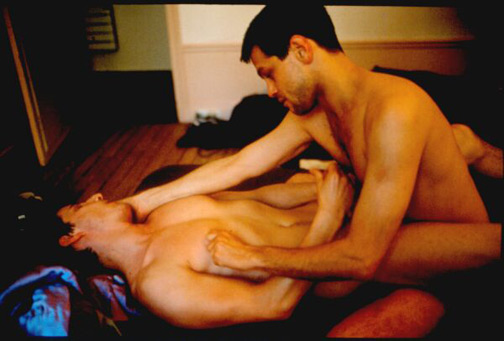
Nan Goldin - Clemens squeezing Jens' nipples. Paris. 2001
183.00 x 122.00 x 2.50 cm Galerie Yvon Lambert
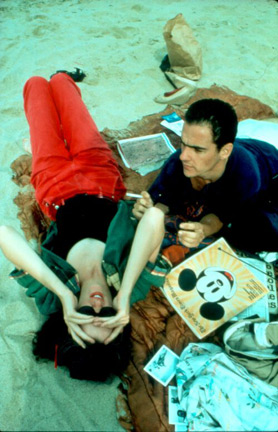 |
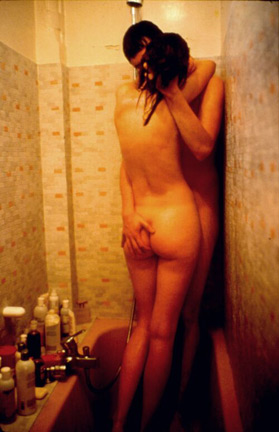 |
|
| Nan Goldin - C. Z and Max on the beach. Truro. MA. 1976. 104.00 x 72.00 x 4.50 cm Matthew Marks Gallery | Nan Goldin - Simon and Jessica kissing in my shower, Paris 2001, Matthew Marks Gallery |
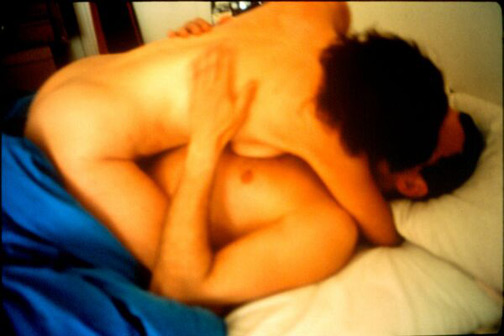
Nan Goldin - Valerie and Bruno in bed with blue blanket. Paris. 2001
72.00 xI 04.00 x 4.50 cm. Matthew Marks Gallery
Could you please tell us something about the people, the artists who have influenced your art?
My biggest influences are my friends. Bruce was one of first persons that introduced me to slide shows in the 1970s. I started doing slide shows because I left school. During school I went to live in Provincetown, a gay resort three hours away from Boston. It is the farthest point in America's east coast. It is beautiful. It is a little community of artists. Norman Mailer lives there. A lot of painters and writers live there. In the 1970s it was really wild with Waters, Cookie, Sharon, and Sharon's son. It was incredibly wild. Later everything has completely changed. In Provincetown we used to live in small groups. I took lots of pictures of my friends, like "Bruce in the snow". I've known Bruce since 1972. We lived together with Bruce, Sharon, and Cookie. I was at the School at the Museum of Fine Arts. Those days the school was that teachers sat in the parking lot and drank. Literally. This was before the 1980s. We were told that we will never make any money on art. Now, the students that I teach, at Yale particularly, all they want to know is what gallery they could have a show in or could I help them to get a show. They go right from the graduate school to the big galleries. It is all a career move. When I went to art school, I never heard of Artforum. Never. I took classes in Russian literature, in Faulkner, whom I love. I took writing classes, I took the history of film, I took drawing to be able to see better, because many photographers cannot see anything.
I actually became very influenced by Rothko. I love the work of Richard Todd, but I cannot say he was an influence. Anything that I see and I love is an influence, but I never try to replicate somebody else, like I never tried to make a Rothko. I love Caravaggio, but I never studied Caravaggio. I never made any Caravaggios. Some of my pictures of boys having sex, they have the same sense of light as Caravaggio. Caravaggio also knew all the people that he painted. They were his lovers or hustlers. Pasolini used boys from the street that he loved that he desired. Fassbinder only used people he knew. Cassavetes used the same people over and over, so I am not the first one to do that, but I think that people have forgotten how radical my work was in the 1980s, when I started, because nobody was doing work like that. Now, so many people have done work like that like Wolfgang Tillmans, Juergen Teller, Corinne Day... Now people think I am just one of many who've done that. They do not understand that The Ballad of Sexual Dependency was so radical when it came out.
I was very influenced by film, because I did not go to high school. I went to the movies. Sometimes I went to the movies two or three times per day. I saw every movie from the 1940s and the 1950s. I saw every movie where all those goddesses were... Every movie with Marlena Dietrich, every movie with Bette Davies, every movie with Barbara Stanwyck, every movie with Marilyn Monroe. Then I saw an enormous amount of Italian movies with Antonioni, Pasolini, de Sica... I was very influenced by Cassavetes. When I am influenced, unlike many other contemporary photographers, I would never take a scene from the movie. I was very influenced by Fassbinder and KieŚlowski. I saw his "Ten Commandments." How do you pronounce his name? Yes, he is very important to me. Also Fassbinder was important. I saw all his works.
Did you make any movies?
Yes, I made two documentaries. "I'll Be Your Mirror" was made with the BBC. It is about my life. The other was made with Joana and Aurele. It is about AIDS and it is called "Ballad at the Morgue." He has AIDS and she does not. It is about a couple, about a relation of a couple, where one person is HIV-positive and the other is not. The film has only been shown in Turin.
What about music?
Yes, it is very important to me. Now, I am very influenced by Nick Cave. He saved my life, literally.
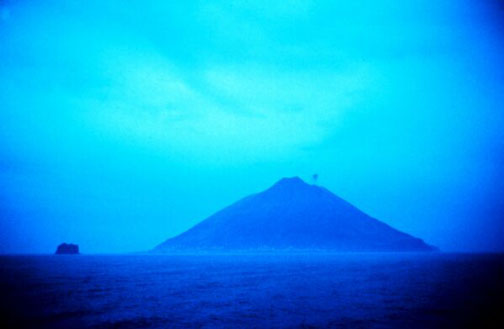
Nan Goldin - Volcano at dawn. Stromboli. ltaly. 1996
121,.50 x 182.50 x 2.50 cm Matthew Marks Gallery
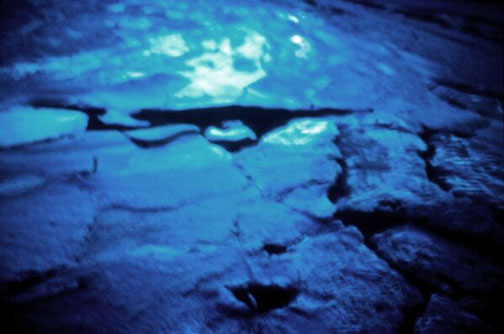
Nan Goldin - Moss covered rocks. Iceland. 1999
72.00 xI 04.00 x 4.50 cm. Matthew Marks Gallery
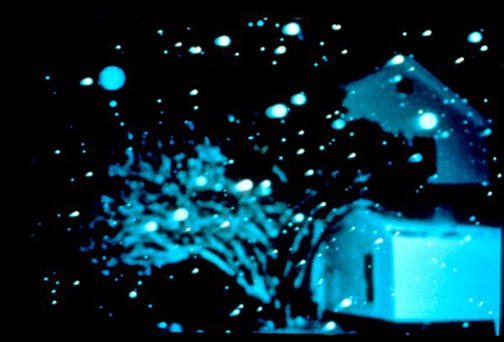
Nan Goldin - Villa Bovina. NY. New Year's Day. 2001
121.50 x 182.50 x 2.50 cm. Matthew Marks Gallery
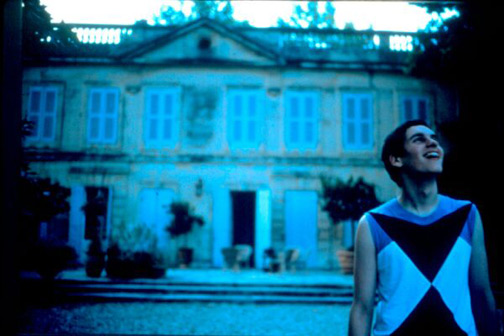
Nan Goldin - Simon laughing. Yvon's house. Avignon. 2001
72.00 xI 04.00 x 4.50 cm. Matthew Marks Gallery
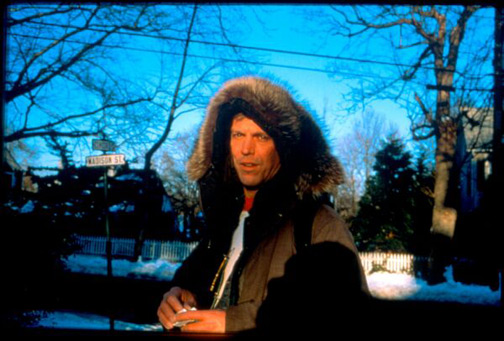
Nan Goldin - David wearing his hood on my street. Sag Harbor. 2001
72.00 xI 04.00 x 4.50 cm. Matthew Marks Gallery
You were one of the few photographers who started to take color pictures. How did it happen?
I accidentally used the roll of color film in my camera. I thought it is black and white, but it was color.
Unlike Egglestone and the other photographers using color, your pictures were discovered quite late.
Some people discovered my photography early. It was just very underground. It was very good what they taught us at the art school: that you have to suffer to be an artist; that you do not need material, financial success, but you have to be driven. A lot of great artists came out of my school from that period. Some of them are my friends like David Armstrong and Philip Lorca diCorcia. When I first started to take pictures of drag queens my influences were glamour magazines, fashion magazines. I like Horst, Cecil Beaton, and the early work of Newton, I like Guy Bourdin. I did not know about art photography. In 1974, I went to school and there was a teacher who showed me Larry Clark. It has entirely changed my work. I knew that there had been somebody else who had done their own life. You know his book Tulsa? I knew that were precedents for using one's private experiences as art.
So you just switched from this glamour photography to this very personal approach?
No, I did not just switch. It was a long process of learning about the history of photography. He introduced me to August Sander, Weegee, Diane Arbus. The drag queens hated the work of Arbus. It was not allowed in the house, because they hated the way she photographed drag queens. She tried to strip them of their identity. She did not respect the way they wanted to be. Arbus is a genius, but her work is about herself. Every picture is about herself. It is never respecting the way the other person is. It is almost a psychotic need to try to find another identity, so I think that Arbus tries on the skin of other people. I have written a lot about Arbus.
Some critics find connections between you and Arbus. What do you think about such comparisons?
The daughter of Arbus thinks that there is no connection at all. I think there is some connection, because both of us have an unusual degree of empathy, but it is manifested in a different way. She was a photographic genius and I am not a photographic genius. My genius, if I have any, is in the slideshows, in the narratives. It is not in making perfect images. It is in the groupings of work. It is in relationships I have with other people.
Is it not connected with your fascination with literature? You mentioned Faulkner...
Faulkner wrote about one tiny community and he wrote around 25 great novels and many short stories. They are always set in the place he loves. It has an invented name, but it is a real place. It is all based on what he knows. I always fought strongly against traditional documentary photography. It has changed, but in the 1970s it was always strong white men going to India, making exotic pictures of something they have no idea of. I always felt that I have right to photograph only my own tribe or people, when I travel, to whom I get close to and that I gave something to. I never took pictures with a long lens, it is always short and I have to get close to people I photograph.
What is the relation between the diary you write and the pictures you take?
Nothing. My diary is really boring.
Have you not tried to put together both diaries, textual and visual, and do something like Peter Beard?
No. I think these are two different things...
Have you ever published parts of this diary?
No, I would never do this. I am writing it for myself and nobody else. My wish is to burn it immediately after my death...
Some of your pictures are blurred. You did it on purpose?
Actually, I take blurred pictures, because I take pictures no matter what the light is. If I want to take a picture, I do not care if there is light or no light. If I want to take a picture, I take it no matter what. Sometimes I use very low shutter speed and they come out blurred, but it was never an intention like David Armstrong started to do what we call, he and I, "Fuzzy-wuzzy landscapes." He looked at the back of my pictures and studied them. He started to take pictures like them without people in them. They are just out of focus landscapes. He actually did it, intentionally threw the camera out of focus. I have never done it in my life. I take pictures like in here when there is no sun or light that I think all my pictures are going to be out of focus. Even Valerie and Bruno and whatever I take, because there is not enough light, and so I use a very low shutter speed. It used to be because I was drunk, but now I am not. The drugs influenced all my life. Both good and bad. I heard about an artist in Poland, Witkacy, who wrote down on his paintings all the drugs he was on. Depending how many drugs he took, that is how much he charged for the portrait. I saw his portrait at the National Museum, a kind of German expressionism, and I loved it.
I saw your pictures in the 50th anniversary issue of Aperture magazine. What shocked me most was the relation between them and the new Leica ad - this one with your hands holding the M7, very artistic and black and white - I never thought of your photography being as classic as Leica.
I always use Leica. Previously it was M6, and recently I work with M7 camera. I received one as a salary for this particular ad. However, I immediately lost it while photographing the "Valerie floating" series. I was swimming with her holding my camera in one hand and taking pictures at the same time. It was really difficult. The camera got broken, but the photographs were really worth the price.
How do you feel having these radical works being shown at the most prestigious museums?
In Paris, for instance, I had a choice between the Centre Pompidou, where all the people go, and the most beautiful museum in Paris, Musee de la Ville de Paris. I liked the women who worked at the museum, but I also loved the man who was taking over the Pompidou. I am very loyal to anybody who has helped me, especially before I was famous. Some told me that I should choose this beautiful museum, but I chose the Pompidou, because I wanted people to see it. To the beautiful museum go only artists and elites.
What are you going to do next? After the Devil's Playground and the Matthew Marks show in New York?
I do not know. I never know. I think it is going to be something different, because I have been through hard times. We will see how the market will react to this, but I do not care about the art market at all. My dealers are becoming greedier and greedier. They start talking to me in this strange way saying "We will show this and this picture, because they are going to sell well." I am worried about that they no longer even pretend to have any ideals. At least my American dealers.
Interview by Adam Mazur and Paulina Skirgajllo-Krajewska
13 February 2003, Warsaw
Proofreading: Simon Cygielski
See also:

Nan Goldin - The sky on the twilight of Philippine's suicide. Winterthur. Switzerland. 1997
72.00 x 104.00 x 4.50 cm. Mathew Marks Gallery
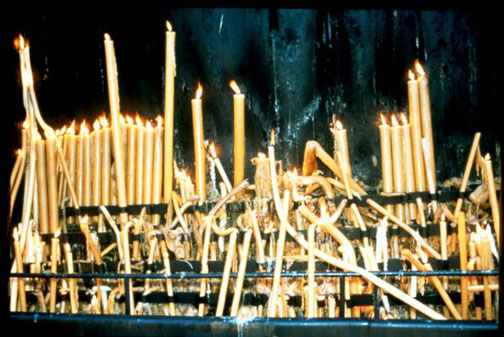
Nan Goldin - Fatima candles. Portugal. 1998
122.00 x 183.00 x 2.50 cm Galerie Yvon Lambert
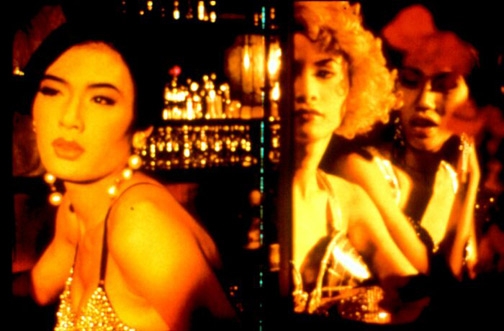
Nan Goldin - At the bar: C. Toon and So, Bankok 1992, Matthew Marks Gallery
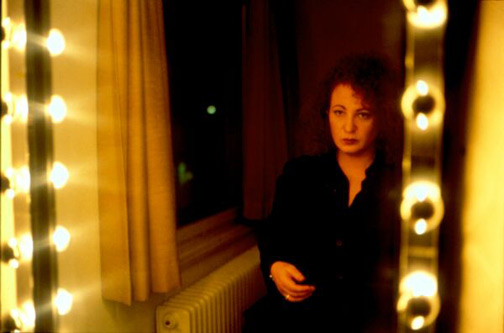
Nan Goldin, Self-portrait in hotel Baur au Lac, Zurich, 1998, Matthew Marks Gallery
Copyright © 1997-2025 Marek Grygiel / Copyright for www edition © 1997-2025 Zeta-Media Inc.